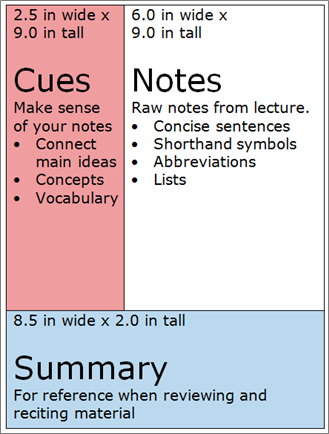Cornell Note-taking
Cornell Note-Taking System

Download the note-taking template (doc)
First: Prep
Occurs before class begins.
- Divide notebook paper into 3 sections, as shown in the diagram.
- Write the course name and date at the top of each page.
Second: Notes
Occurs during class itself.
- Record facts, ideas, and examples. More important information is generally placed on the board or emphasized/repeated by your instructor.
- Leave space between ideas and topics
- Place a question mark next to something you do not understand in the moment. Clarify any confusion after class by speaking with your professor, classmates, or reading the textbook.
Third: Cues
Occurs as soon as possible after class.
- Make sense of your notes by connecting ideas together. Re-read your raw lecture notes to generate:
- Meaningful reminders and mnemonics
- Simple diagrams
- Questions you can ask yourself at a later date to check whether you remember information from this particular class.
- Example of questions to ask yourself:
- What is the significance of Napoleon, secularism, democracy, and the late 1700s with the French Revolution?
- How do ATP, Creb Cycle, and Photosynthesis fit together?
- How does z (standard score) fit in with what I already learned about normal bell-curve?
- What principles is balancing chemical equations based on?”
- How can I apply the elements of a persuasive essay to my own argumentative paper?
- If your Notes section is difficult to understand (or contains missing information), incorporate supplemental material from the textbook, office hour visits, classmates, or internet.
Fourth: Summary
Occurs after completing the Cues section.
- At the bottom of each page, write a 3-4 sentence summary that encapsulates the main ideas of each page.
Fifth: Review and Recite
On a consistent, daily basis.
- For best results, review your Cues and Summary sections several times per week.
- Make sure you understand what you wrote and can answer each question you asked yourself.
Further information on note-taking can be found at James Madison University and Nazareth University.
SUNY Cortland students may also schedule an appointment with a professional tutor at the The Learning Center by calling 607-753-4309 or visiting Van Hoesen Hall, Room B-205.

